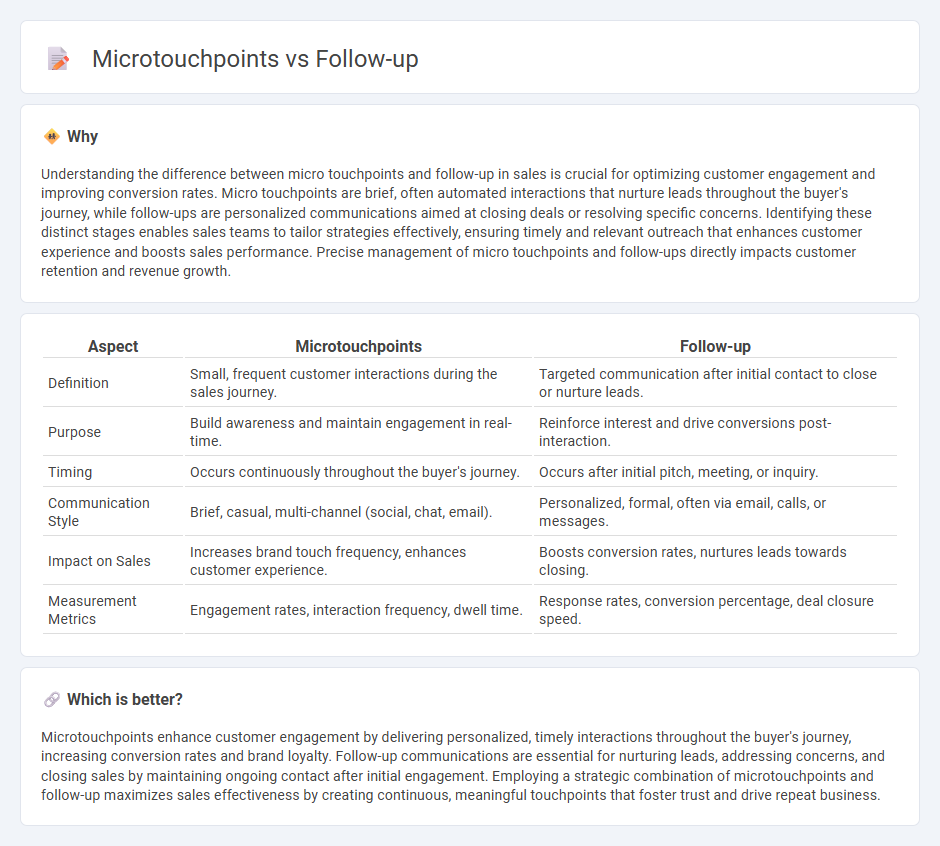
Microtouchpoints are brief, targeted interactions designed to engage customers at critical moments, boosting brand awareness and fostering trust efficiently. Follow-up strategies involve deeper, personalized communication after initial contact to nurture leads and close sales effectively. Explore how combining microtouchpoints with strategic follow-up can maximize your sales performance.
Why it is important
Understanding the difference between micro touchpoints and follow-up in sales is crucial for optimizing customer engagement and improving conversion rates. Micro touchpoints are brief, often automated interactions that nurture leads throughout the buyer's journey, while follow-ups are personalized communications aimed at closing deals or resolving specific concerns. Identifying these distinct stages enables sales teams to tailor strategies effectively, ensuring timely and relevant outreach that enhances customer experience and boosts sales performance. Precise management of micro touchpoints and follow-ups directly impacts customer retention and revenue growth.
Comparison Table
| Aspect | Microtouchpoints | Follow-up |
|---|---|---|
| Definition | Small, frequent customer interactions during the sales journey. | Targeted communication after initial contact to close or nurture leads. |
| Purpose | Build awareness and maintain engagement in real-time. | Reinforce interest and drive conversions post-interaction. |
| Timing | Occurs continuously throughout the buyer's journey. | Occurs after initial pitch, meeting, or inquiry. |
| Communication Style | Brief, casual, multi-channel (social, chat, email). | Personalized, formal, often via email, calls, or messages. |
| Impact on Sales | Increases brand touch frequency, enhances customer experience. | Boosts conversion rates, nurtures leads towards closing. |
| Measurement Metrics | Engagement rates, interaction frequency, dwell time. | Response rates, conversion percentage, deal closure speed. |
Which is better?
Microtouchpoints enhance customer engagement by delivering personalized, timely interactions throughout the buyer's journey, increasing conversion rates and brand loyalty. Follow-up communications are essential for nurturing leads, addressing concerns, and closing sales by maintaining ongoing contact after initial engagement. Employing a strategic combination of microtouchpoints and follow-up maximizes sales effectiveness by creating continuous, meaningful touchpoints that foster trust and drive repeat business.
Connection
Microtouchpoints play a crucial role in sales by creating multiple small interactions that keep potential customers engaged throughout the buying process. Effective follow-up leverages these microtouchpoints to build trust, address concerns, and reinforce value propositions, increasing the likelihood of conversion. Consistent engagement through microtouchpoints and timely follow-up drives higher customer retention and accelerates sales cycles.
Key Terms
Lead Nurturing
Follow-up strategies involve personalized communication to re-engage leads after initial contact, enhancing conversion rates through timely outreach and relevant content. Microtouchpoints leverage small, frequent interactions such as social media engagements, targeted ads, or email snippets to maintain brand presence and gradually build trust. Explore how combining follow-up methods with microtouchpoints can optimize lead nurturing and accelerate sales cycles.
Customer Engagement
Follow-up strategies deepen customer relationships by providing personalized communication after initial interactions, enhancing brand loyalty and trust. Microtouchpoints involve multiple brief interactions across various channels, maintaining constant engagement and boosting brand recall. Explore effective techniques to optimize both approaches for maximizing customer engagement and retention.
Conversion Rate
Tracking follow-up interactions reveals their direct impact on boosting conversion rates by nurturing leads and addressing objections promptly. Microtouchpoints, such as personalized emails and targeted social media ads, significantly enhance customer engagement and incremental sales opportunities. Discover how optimizing both strategies can maximize your overall conversion performance.
Source and External Links
Follow Up, Follow-Up, or *Followup | Correct Spelling - This article explains the correct usage of "follow up" as a verb and "follow-up" as a noun or adjective, highlighting that "followup" is considered incorrect by most authoritative dictionaries.
Follow up, Follow-up, Followup: Which One is Right? - This blog post clarifies the distinction between using "follow up" as a verb, "follow-up" as a noun or adjective, and notes that "followup" is not standard, though some dictionaries list it as an alternative.
follow-up - Wiktionary, the free dictionary - This entry defines "follow-up" as a noun referring to a subsidiary action taken in response to an event, and provides examples in various contexts, including internet and sports.
 dowidth.com
dowidth.com